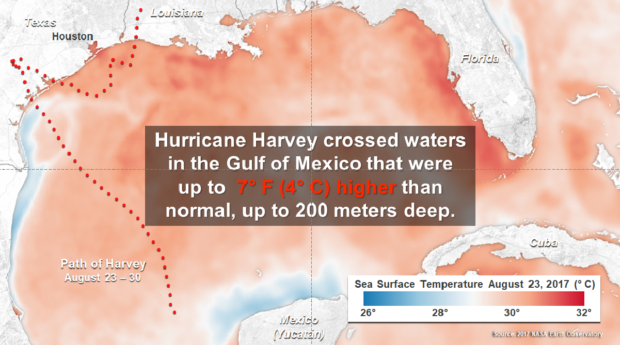Al Gore Visits Hurricane Harvey Victim: Houston, Texas
Two months after hurricane Harvey inundated Houston with 51 inches of rain, former Vice President Al Gore returned to a packed Rice University basketball arena to empathize with Houstonians impacted, share his climate analysis on what made Harvey unlike prior hurricanes, and chart a path forward for the global community.
Houstonian James Cargas was there. Cargas, who worked in the Clinton-Gore White House at the President’s Council on Sustainable Development, said “I have always admired Vice President Gore’s persistence and dedication to halting and reversing climate change – a great challenge that appears unsolvable, but really can be achieved.”

James Cargas, Dr. Dorina Papageorgiou and Vice President Al Gore; photo courtesy of James Cargas
Al Gore received the Nobel Peace Prize in 2007 for his work to raise awareness of man-made climate change and to counteract its impact. He is also Chairman of the Climate Reality Project.
Gore opened with devastating pictures and videos of Texas neighborhoods the audience recognized immediately. For several of these neighborhoods it was their third “500-year flood” in three years. They were flooded in the Memorial Day Flood of 2015, again in the Tax Day Flood of 2016, and again by hurricane Harvey in 2017. Harvey flooded thousands of homes that were previously considered safe.
Harvey was different and more devastating than previous storms, Gore explained, because it gained tremendous strength from above average water temperatures deep in the Gulf of Mexico and Caribbean. It was the first time a Gulf storm increased in intensity prior to making land fall. Normally when a storm churns up the Gulf’s waters, the deeper cold water weakens the storm. In 2017, however, this deep water was significantly warmer and acted like an accelerator, not a brake. Harvey also moved unusually slowly along the Texas coast with one arm reloading with water while the other arm disgorged that water indiscriminately on Texans.
“I regret to say that these conditions are becoming the new norm,” Gore warned. “There will be more Harveys in the future as the Gulf warms up. It doesn’t take a large temperature difference to make a big impact.”
Cargas explained to NEO, “Houston has enjoyed great economic and population growth but the U.S. Corps of Engineers have not significantly improved flood control measures since the 1950’s.” Cargas is the City of Houston’s energy lawyer and a candidate for Texas’ Seventh Congressional District where much of the repeat flooding is happening. “Climate change is exasperating Houston’s vulnerabilities,” he added.
After walking through the science and depressing the crowd that came to see him on a Monday evening, Gore said, “it’s happening everywhere.” He showed that Houston is not alone and that other communities in the United States, Caribbean, Asia, Africa, Greenland, Europe, and Middle East are all experiencing more extreme weather and greater precipitation. He pointed to the resulting crop failures, refugee movements, disease and wars as all being the direct result of climate change upending societies, economies and agriculture.
“It’s no coincidence that 1.5 million Syrians moved to already crowded cities after 60% of Syria’s fertile land became desert which created social pressures and civil war,” Gore gave as one example.
“Gore made a passionate case for the need to change our impact on the thin layer of Earth’s atmosphere we live in, and he backed it all up with hard solid science,” Cargas who is married to a scientist said.
That scientist, Dr. Dorina Papageorgiou, a neuroscientist at the nearby Texas Medical Center, was also there among the 4,000 people in attendance. “Hearing that temperatures reached 129 degrees Fahrenheit in Iraq this summer did not really register until Al Gore showed us how asphalt roads melted and shoes got stuck in the gooey liquid pavement,” Papageorgiou exclaimed.
The former Vice President also reminded the crowd that temperatures hit a record 111° F (43° C) in Athens, Greece this past summer.

Just when the audience was convinced we are all heading towards global extinction, Gore offered options for reversing course. The one that earned cheers from Houstonians was how the deployment of renewable energies would drastically cut carbon and other emissions.
“Markets are reacting and rewarding clean energy generation and storage, and digitally empowered energy efficiency and waste reduction.” Gore continued, “A world powered by clean energy is possible and within reach. We must be the drivers of progress.”
Cargas, the energy lawyer, was thrilled to hear Gore challenge the World’s Energy Capital to lead our planet’s future with renewable energy deployment here and around the globe.
In 2000, experts predicted the world would have 30 gigawatts (GW) of wind energy installed. But with the cost of wind turbines falling dramatically every year, the technology has taken off. “That prediction was very wrong,” Gore declared, “the reality is that by 2016, the world had sixteen times that amount.” Of the 480 GW of global wind production installed, the United States accounts for 84 GW.
The state leading this rapid deployment? Texas, of course! Today, Texas has 21 GW of wind power capacity which is more than any other state. By the end of 2018, Texas will produce more electricity from wind than coal.
Gore then showed how the story is the same for solar power. In 1976, it cost $79.49 per watt for solar generation. In 2016, that cost has plummeted to 41¢ per watt. “Solar energy jobs are growing 17 times faster than the overall economy,” Gore shared with an audience who has seen thousands of fossil energy jobs eliminated since the price of oil fell.

James Cargas and Al Gore campaigning in Dallas in 2000
Cargas was part of the Mayor’s team that brought a 50 megawatt (MW) solar power plant on-line that will supply the City’s meters with affordable energy for 20-years. The City of Houston is the 8th largest purchaser of renewable energy in America according to the U.S. Environmental Protection Agency.
Like wind power, the rapid deployment of solar technology has seen total US solar generation shoot to 44.7 GW. While the majority of electricity is still produced with fossil energy, renewables are closing the gap. Seventy percent of all new power generation construction in the United States is either wind or solar.
The most drastic gains, however, remain elsewhere. Developing nations are leap-frogging into new renewable technologies just like they did during the cellular phone technology boom. In Chile, renewable energy went from 11 MW in 2013, to 402 MW in 2014, and then 848 MW in 2015. In 2017, Chile now has 13,300 MW approved or under construction.
While wind and solar generation are being rapidly deployed around the world, hundreds of carbon emitting power plants running on coal are being retired. This includes the United States where old and inefficient coal plants can no longer compete with cheaper renewable energy.
In addition to cleaner air, 2.6 million Americans now work in the solar, wind, and energy efficiency sectors. The smallest sector, solar, now accounts for two times the number of jobs as the coal industry.
In his concluding remarks, Gore showed that the rapid and ongoing renewable energy boom is working, “global emissions of carbon dioxide (CO2) have stayed flat three years in a row. The first time in 40 years without the presence of an economic crisis.”
“The story of climate action is one of hope and progress, not despair,” Gore said, “This is our road forward.”















0 comments